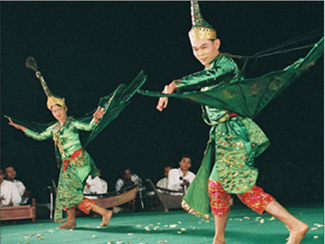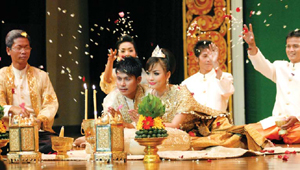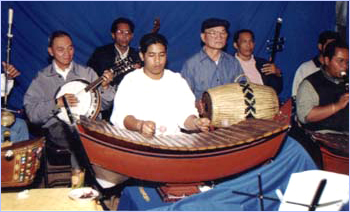Khmer Art and Culture
Throughout Cambodia's history, religious principles guided and inspired its arts. A unique Khmer style emerged from the combination of indigenous animistic beliefs and the originally Indian religions of Hinduism and Buddhism. These two religions, along with the Sanskrit language and other elements of Indian civilization, arrived in mainland Southeast Asia during the first few centuries ad.
Seafaring merchants following the coast from India to China brought them to the port cities along the Gulf of Thailand, which were then controlled by the state of Funan in Cambodia. At varying times, Cambodian culture also absorbed Javanese, Chinese, and Thai influences.
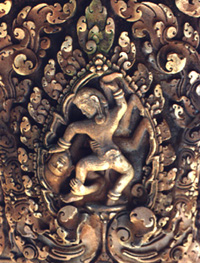
Between the 9th and 15th centuries, a prosperous and powerful empire flourished in northwestern Cambodia. The Khmer kingdom of Angkor, named for its capital city, dominated much of what is now Laos, Vietnam, and Thailand. The kingdom drew its religious and political inspiration from India. The literary language of the court was Sanskrit; the spoken language was Khmer. Massive temples from this period, including Angkor Wat and the Bayon at Angkor Thum, testify to the power of Angkor and the grandeur of its architecture and decorative art. The unparalleled achievements in art, architecture, music, and dance during this period served as models for later cultural development in Cambodia.
Angkor faded into obscurity after the capital moved south to Phnom Penh in the 15th century, probably due in part to frequent invasions by the neighboring Thais. The jungle rapidly grew over the monuments. In the centuries that followed, frequent wars reduced the territory, wealth, and power of Cambodian monarchs. However, an independent state with its capital near Phnom Penh survived until the 19th century. The most important work of Cambodian literature, the Reamker (a Khmer-language version of the Indian myth of the Ramayana), was composed during this time.
France, which began administering Cambodia in 1863, rediscovered the temples at Angkor and worked to preserve them beginning in the early 20th century. Cambodia's traditional culture and the monuments of Angkor were endangered between 1970 and 1990 due to civil war. The Communist Khmer Rouge regime, which opposed and mistrusted religion and education, banned all of Cambodia's traditional arts and its written language. Since 1991, when Cambodia's warring factions signed a peace accord, international organizations have helped the Cambodian government restore the sites at Angkor and revive Cambodia's traditional crafts.
Type of Khmer Art & Architecture
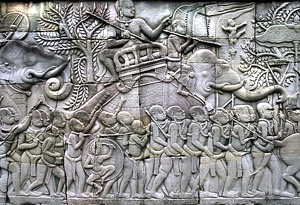
1. Sculpture
The stone carving skill of the ancient Khmer was basically inherited from the Indian civilization, however, it was later evolved into its own unique Khmer style. The Khmer sculptures were carved from stone with great craftsmanship and many of them represent the Hindu deities such as Shiva, Vishnu, Brahmans, the elephant god Ganesha and many other gods and goddesses, as well as Hindu mythical monsters such as the serpent naga, the demon kala, the giant makara, and the mythical lions. Some large sculptures even portray the epics of the Hindu myths such as Mahabharata and Ramayana.
In later centuries, the Buddha statues appeared and enshrined in many temples. The most astounding Buddha statues are found in Angkor Thom (Bayon) where the magnificent statues of four-faced Bodhisattava Avalokiteshvara, the lord Buddha, were sculptured on fifty towers. Although each sculpture bears the common characteristics of the supernatural being it represents as described in the epics or myths, its details reveal the personal imagination of its sculptor. In addition, some sculptures depict the important events such as the war against its foreign invaders while some reveal the everyday life of the Khmer people such as the relief carvings of Angkor Thom.

2. Architecture
The house of the local people in ancient Khmer was more or less similar to those found today in villages of modern Cambodia. It was elevated about two and a half meters above the ground with the wooden ladder and was built by wooden piles which supported the floor, the walls and the roof. The wall was made up of either the straws or the bamboo with the roof covered with the thatched leaves of dry coconut palms.
The architecture of the dignitaries' houses and the palaces was somewhat different from those of the laymen, and differed in sizes, layouts and dimensions. The materials used to built the house consisted of stronger wooden planks, generally made up of teakwood, and the roof was covered with tiles for the inner rooms and with thatched leaves for the outer corners. These differences clearly identified the classes of the people by which the laymen were not even dare to put up a single tile on their roof.
According to Hinduism, the gods reside in the five sacred mountains with central Mount Meru and these mountains are surrounded by the cosmic ocean. The structure of the Khmer temples mostly symbolizes the heavenly residence of the gods with five towers, called Prasats. The central dominant tower or Prasat represents the Mount Meru with four smaller ones, each at its corners, to represent the other four sacred mountains of the heaven. In some temples, there are galleries connecting the towers. The moat surrounding the temple symbolizes the cosmic ocean.





